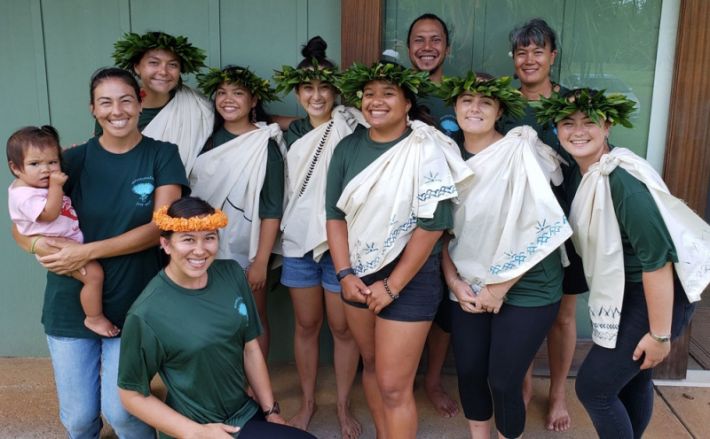“If you no work, you no eat.”
The simple, yet effective call to action is emblazoned upon T-shirts worn by staff and volunteers at the Waipā Foundation, which stewards 100 acres of a 1,600-acre ahupua‘a owned by Kamehameha Schools on Kaua‘i’s picturesque north shore. The Waipā Foundation is led by Executive Director Stacy Sproat-Beck, who manages a team of 14 full-time staff as well as interns and volunteers who assist with everything from educational programming and administration to grounds maintenance and grant writing.
Members of the latest cohort of the Wahi Kūpuna Internship Program, a collaboration supported by KS’ Natural and Cultural Resource Management and ‘Āina Ulu teams, recently held a hō‘ike to detail their efforts throughout the five-week summer program held at Waipā and Lumaha‘i. The interns took on projects around stewardship of the culturally significant resources, and shared their findings with kūpuna and longtime residents of the area.
“If you want people who are passionate and committed to these important cultural sites, it’s a good idea to raise home-grown talent to build this strong foundation,” Dr. Kekuewa Kikiloi, assistant professor at the University of Hawaiʻi at Mānoaʻs Kamakakūokalani Center for Hawaiian Studies, says. Kikiloi works alongside Kelley Uyeoka, executive director of cultural resource management hui Huliauapa‘a and senior director of the Wahi Kūpuna Internship Program, and KS Integrated Resources Manager Dr. Natalie Kurashima to lead the engaging research opportunities that will benefit students and communities for generations to come. The interns actively engage with kumu and alaka‘i in their areas of study to better connect with particular places of interest.
The recently completed cohort picked the name Waiakupalehua, which incorporates the notion of ample water flowing through Waipā, and the groupʻs committment to honor community members who provide ancestral knowledge, while also caring for the precious natural resources as if they were keiki.
Intern Aliana Ho focused her research on mapping Waipā because “This place and its history are going to be passed on for generations to come. When the ʻāina is alive, its people are alive!”
The Wahi Kūpuna Internship Program was launched in 2010, and 100% of its participants are Native Hawaiian or kamaʻāina. Most of the students continue on to graduate with degrees and work in fields related to archaeology, anthropology and culture.
“The land and the community teach us, and you canʻt get that ʻāina-based experience and knowledge in the classroom alone,” Kikiloi says. “Archaeology at its core is a form of ancestral knowledge that lives on through stroies and practices, and this program builds awareness about cultural resource management as a career path.”
Access trails throughout Waipā link a network of learning sites and working farm plots on which kalo, produce and animals are raised.
Sproat-Beck explains that Waipā features a diverse array of programs, including fishpond cultivation and maintenance as well as wa‘a sailing along the coastline, and a series of lo‘i kalo and gardens that produce herbs, pumpkins, kale, lettuce, and even watermelons.
“Our mission is to connect people to the ʻāina that feeds us,” Sproat-Beck says. “We focus on creating alternative approaches to farming, while also holding on to our traditional values and practices.”
Kama‘āina and malihini alike flock to Waipā on Thursdays for “Poi Day,” a weekly tradition that allows farmers to cultivate the kalo and produce fresh poi and paʻi ‘ai in a Department of Health-approved production facility. The kalo products are sold on site and around the island to help sustain the program. Poi Day also features potluck lunch and farm-to-table events at the site’s Hale Imu, a gathering hub for the community.
According to research done by Wahi Kūpuna intern Kelsy Jorgensen, Poi Day has been a local tradition for more than 30 years. Farmers like Makana Martin, who started out as “Waipā keiki” learning through the educational programs at the site, now work as kalo farmers.
Members of the Waipā team distribute the poi throughout the island, a service which helps local residents avoid the traffic to and from the north shore. Some residents come from as far as Niʻihau to pick up their standing orders.
“Our goal is to create poi eaters and retain poi eaters,” Sproat-Beck says. “We’re feeding the kūpuna poi so they’ll feed it to their mo‘opuna so the next generations will eat poi. And, we’re not doing that because we want to sell poi at $10 per pound. We’re doing it because it’s our cultural practice and it’s good for them, and it’s good for us – it’s what we do.”

The recently completed cohort of the Wahi Kūpuna Internship Program, which chose the name Waiakupalehua, took on projects under the guidance of their kumu around stewardship of the culturally significant resources, and shared their findings with kūpuna and longtime residents of the area.

Kama‘āina and malihini alike flock to Waipā on Thursdays for “Poi Day,” a weekly tradition that allows farmers to cultivate the kalo and produce fresh poi and paʻi ‘ai in a Department of Health-approved production facility. The kalo products are sold on site and around the island to help sustain the program.
TAGS
partnering for success,
hawaiian culture based education,
'āina stewardship
CATEGORIES
Kaipuolono Article, Regions, Kaua’i and Ni’ihau, Themes, Culture, Community, Newsroom, Community Education, Department News, Features
Print with photos
Print text only










